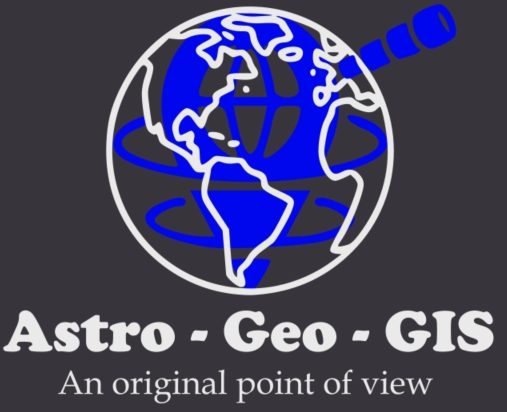As an eclipse chaser, I try to conduct as many professional observations as possible from every eclipse. Practically, I miss some of them because of a lack of funds or, at the very least, decent webcams in the areas where they occur. Last, my scientific conundrum isn’t covered by anyone who attends on-site. Therefore, the eclipse is classified as a missed event. Before I made a successful eclipse journey to Spanish Galicia, I observed previous eclipses and collected interesting data suitable for my scientific project.
The text includes the solar eclipses between 2019 and 2022 and explains the phenomena, which have been successfully investigated. This is the first part of the work, which provides for my observations only. In the future, I would like to cover the accidental, yet valuable observations of people from whom I obtained records.
ANNULAR SOLAR ECLIPSE OF DECEMBER 26, 2019
This “Boxing Day” eclipse started in Saudi Arabia and finished in the western part of the Pacific Ocean. I was fortunate to watch it remotely in three places. Two of them had a similar obscuration of 91%. Another one – Dubai, could witness the greatest eclipse with a maximum of 87% of the solar disk covered. In the first one – in Abu Dhabi, the eclipse effect wasn’t noticeable much, as the event occurred shortly after sunrise, when, due to the longer journey of sunlight through the Earth’s atmosphere, the blue wavelengths are scattered away in favor of red and orange wavelengths, which are dominant. The only phenomenon observed in Dubai was the non-uniformity of sky color changes. As the Sun goes higher, it shines through a thinner atmosphere. Therefore, an observer should expect an increment of blue light scattering. In both locations, the eclipse culminated about 35 minutes after sunrise. Both webcams reported inhibited sky coloration changes upon the maximum phase. Next, these changes accelerated as the phase decrement coincided with increasing solar altitude (Pic. 1 – 4).
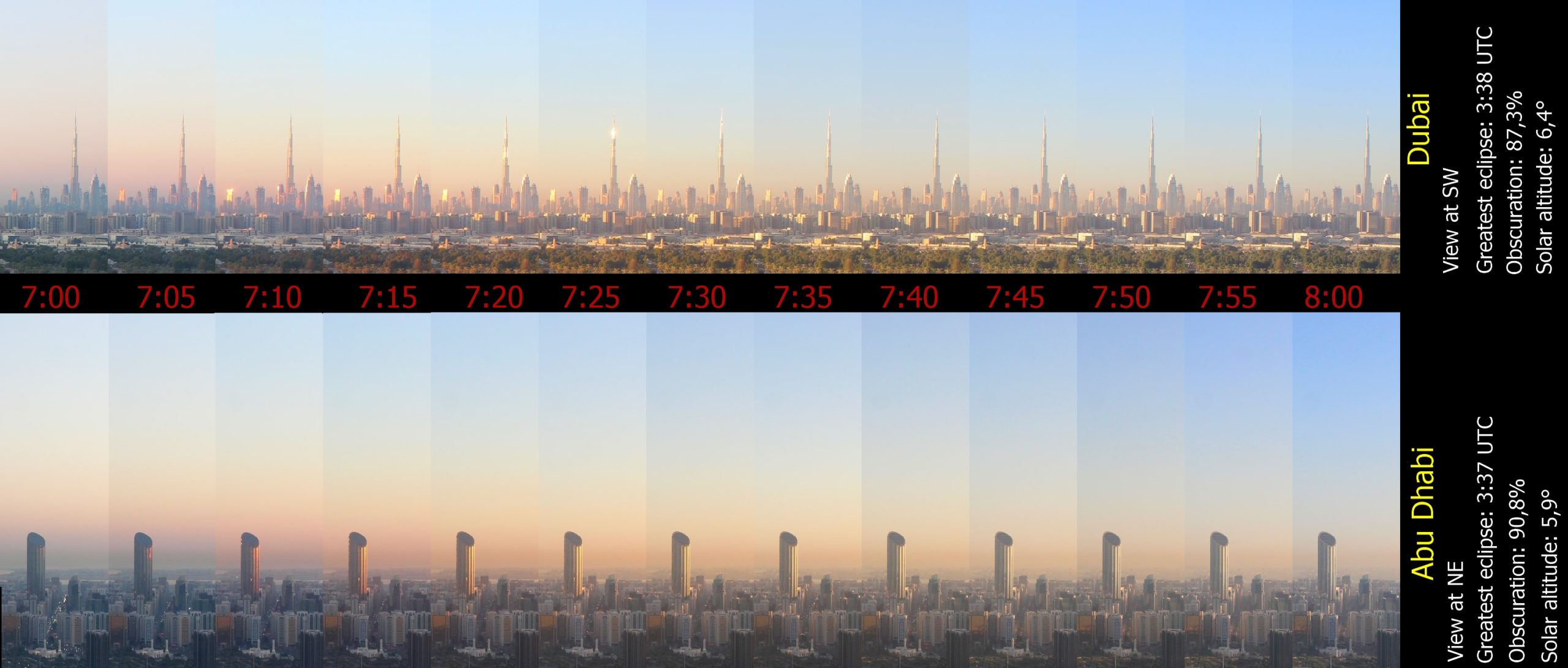
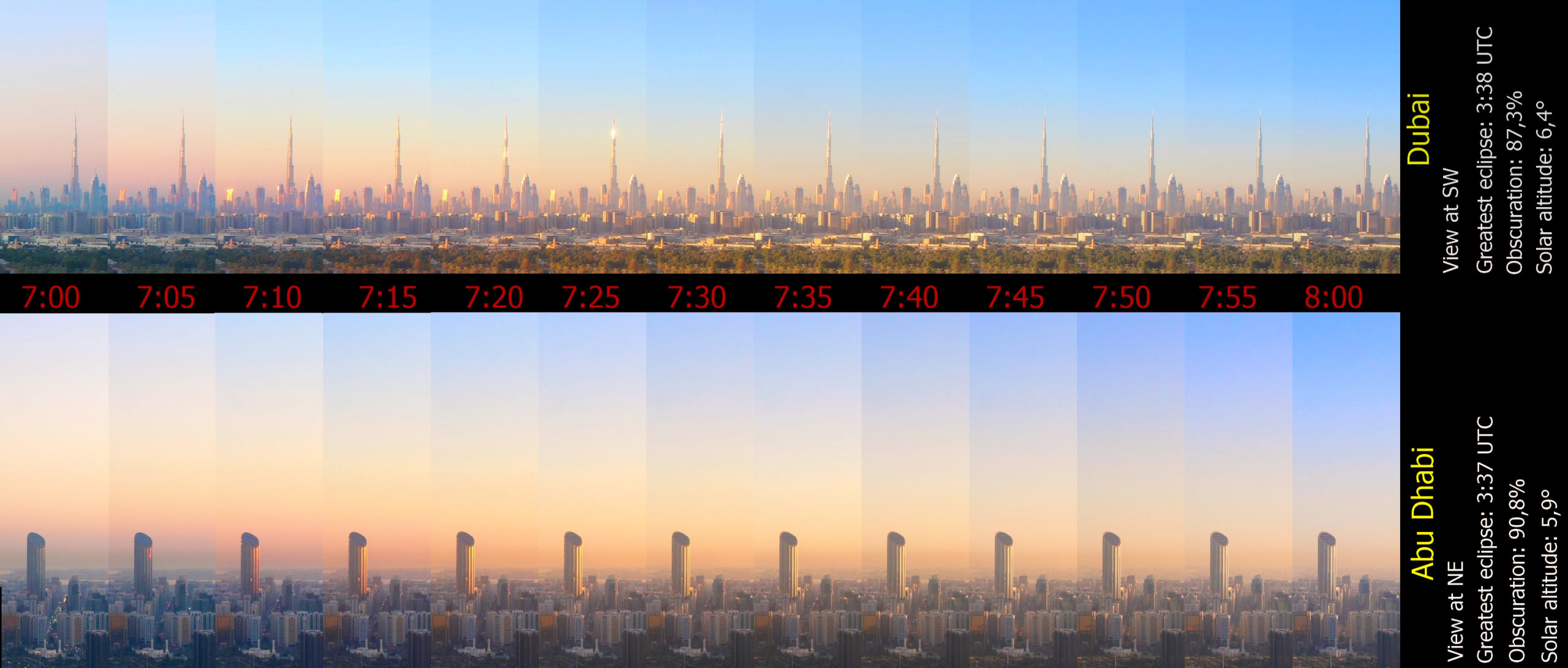


Two unique atmospheric processes are visible here, which can only be observed during a solar eclipse. One of them is Rayleigh scattering. An easily understandable thing that can be noticed in both images is the reduced overall sky brightness. However, observers can see this effect shortly before the greatest phase because the Sun rises. Along with this trivial effect, it’s crucial to understand the basic principle of Rayleigh scattering, which says that the intensity of Rayleigh scattering is inversely proportional to the fourth power of the wavelength (). This means shorter wavelengths (blue light) are scattered much more strongly than longer wavelengths (red light). Indeed, on a typical day, when the Sun is higher in the sky, the blue color prevails, as described in this text. The situation changes when the Sun shines lower above the horizon. Then, by shining through a thicker atmosphere, the short wavelengths are scattered away in favor of the longer ones, which prevail. During the December 26, 2019, solar eclipse, the Sun was going up, changing the proportion of Rayleigh scattering. Meanwhile, the eclipse progress triggered the changes in sky color balance driven by the limb darkening effect. The eclipse magnitude at sunrise exceeded 0.5, meaning that the center of the solar disk was obscured. In this case, the eclipsed sunlight affected the original sky color. When we face a situation such as this, the sky color won’t be typically blue; it will comprise a mixture with a slight reddish tinge and pale blue, eventually giving some greenish blue tone. This disturbance of color balance is also contributed to by increased diffuse sky radiation from the section of the sky, being less affected by the eclipse. The limb-darkening effect contributes more to a deeper partial phase of the eclipse and significantly influences diffuse sky radiation. It’s best visible in the upper pictures (Pic. 1, 2) when looking away from the sun. We can spot that around 7:35-7:40 local time, the sky has a slight reddish tinge when the eclipse reaches the maximum.


The chart below illustrates the eclipse impact in two locations, as shown in the images above (Pics. 5-6), where remote observations were made (Pics. 1-4). They represent quite similar circumstances, which feature mutual eclipse events, such as the first contact around civil dawn and the greatest phase at the end of the golden hour. This observation didn’t cover the period before sunrise. The graph shows the twilight process’s slight slackening, as the obscuration exceeded 40% at sunrise, with the illumination level adequate to the end of civil Dawn at a solar depression of 1,5°. The light level peaks about halfway through the golden hour and tends to drop later. The chart depicts the best upper images of 1 and 2, where the webcam oriented at the near antisolar azimuth captured a slight sky darkening. Other webcams didn’t detect this moment, in which the azimuths were closer to the Sun. They recorded very similar sky illuminance in the 5-minute intervals directly preceding the eclipse maximum. As a matter of webcam ISO sensitivity, it wasn’t possible to observe the darkening of the scene. However, seeing how the sky color balance was affected was definitely a positive side of it.

The same eclipse was observed remotely in another location – Kerala, India. The webcam mounted at the top of the Grand Hyatt Kochi hotel, located near Vembanad Lake in the Kochi agglomeration (Pic. 8), captured an excellent image of limb darkening in the scene.

Apart from the progressively decreased solar flux as the Moon covers the Sun’s disc, there are other atmospheric processes to observe during this event. The changes of Rayleigh scattering described earlier coincide with the limb-darkening effect, especially when the solar disk is covered by more than 50%. Various thicknesses of the solar atmosphere across the visible solar disk cause the limb-darkening effect. In other words, this effect arises from photospheric opacity. The Sun isn’t just a solid sphere with a well-defined surface. It has a diffused border like an atmosphere. When we look at the exact center of the Sun, technically, we can have the most profound insight into our star’s environment, which is hotter and brighter. On the contrary, the solar limb is somewhat analogous to looking through a thick atmosphere where extinction takes place. From an observer’s point of view, the line of sight passes through the solar atmosphere, which is cooler and less bright.
Additionally, the light coming from the solar surface located at peripheral areas of the solar disk is absorbed and scattered as it represents diverse optical depths. Finally, instead of the bright yellow light emitted by the Sun’s surface, the light from the limb is a bit redder. From the thermal point of view, the uneclipsed Sun is as hot as 5800K, whereas the solar limb, which is determined to be an annular ring, is 4600 to 4750K (Schultz, 2024). In the situation when only the solar crescent is visible, the limb darkening effect has a significant impact on the spectral properties of light perceived by the observer and the scene. The image sequence below (Figures 9 and 10) illustrates the significant changes that can occur in the scene during a deep partial solar eclipse.


Around the greatest magnitude, the scene and the sky shifted toward a reddish tinge. In general, a better contribution of the limb darkening effect is noticeable during annular solar eclipses. Even if the phase is just partial, the smaller angular size of the Moon makes the Sun’s crescent more arched and thinner. Limb darkening becomes relevant for spectral solar radiation changes as it leads to wavelength-dependent changes. The radiation at shorter wavelengths is much more pronounced.
ANNULAR SOLAR ECLIPSE OF JUNE 21, 2020
This eclipse belonged to the solar saros 137 series, which reminds the renowned hybrid solar eclipse of April 17, 1912 in western Europe, known as the Titanic eclipse. Latter saros 137 eclipse members were known as the spectacular broken-ring eclipses about which more information was provided in this article. The annular eclipse of June 21, 2020, culminated around Nanda Devi National Park in the western Himalayas. Beside fantastic study of lunar limb profile based upon the observations in north Pakistan, which are available on Xjubier’s website, this annularity could give a splendid opportunity to study the extension of horizontal visual range. Unfortunately, there is no proper documentation about it from the considered area. My observation of this celestial event was also remote. This time, I’ve focused on capturing the Moon’s shadow from the ISS deck, a goal I’ve been trying to achieve since 2016. This time I was successful (Pic. 11 – 14)!
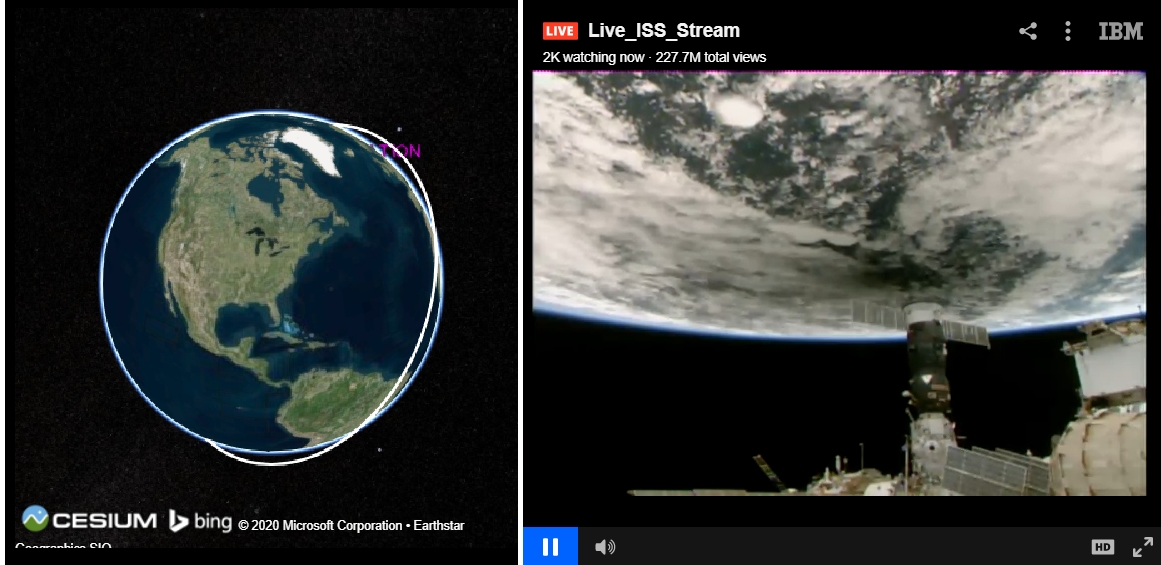
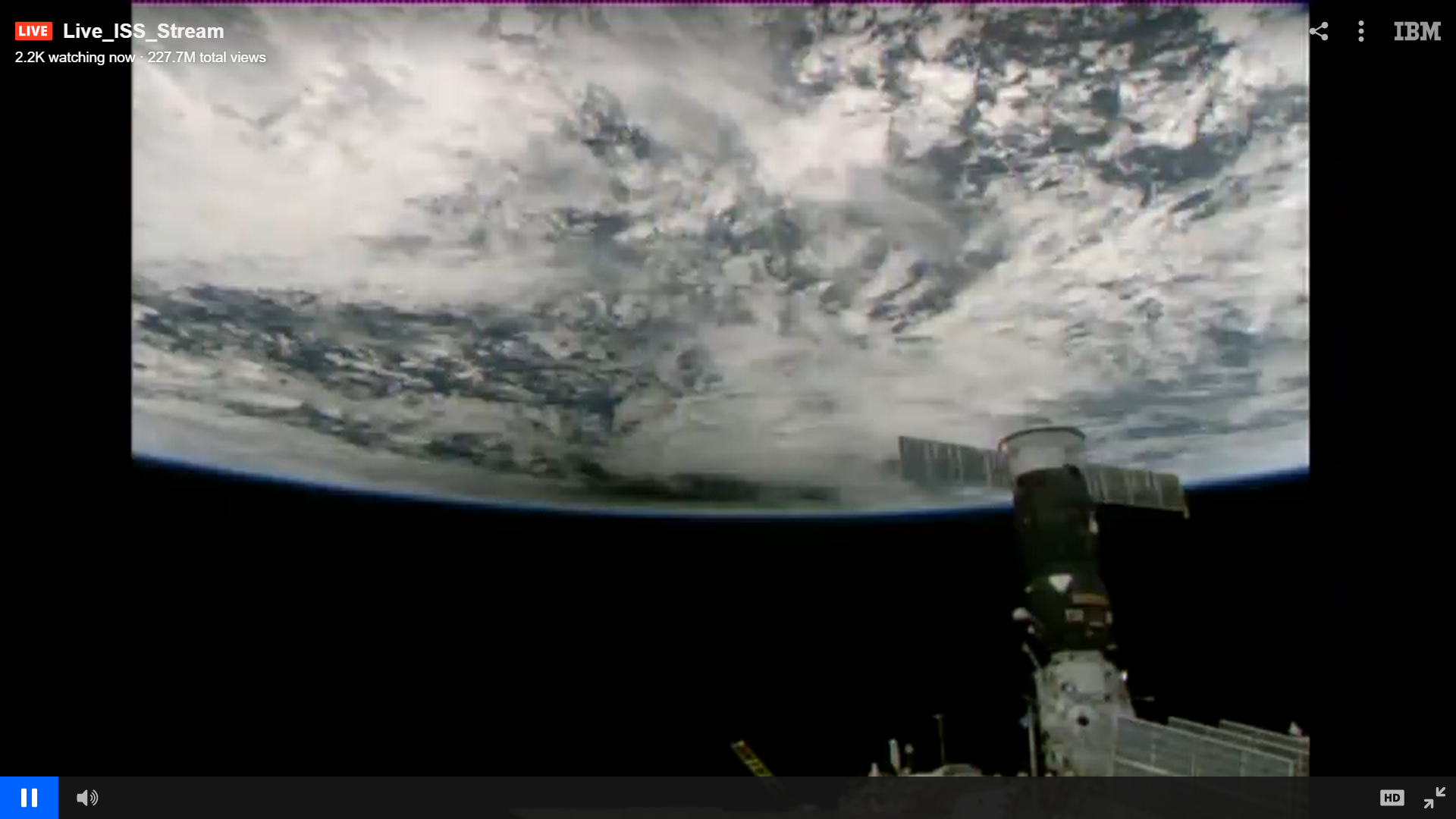


The webstream quality isn’t the best, but we can spot the crucial feature of antumbra. The eclipse was annular, but the antumbra resembles a black hole; likewise, we would have looked at totality. What is the reason behind it? At first, we need to realize that the Moon’s shadow is very small on Earth’s surface. The same, of course, applies to antumbra, as the ratio between the Sun-Moon size and the distance between them and the Earth is almost the same. The Sun is approximately 400 times farther than the Moon, which is about 400 times smaller than the Sun. This perfect coincidence is a result of the relatively small size of the umbra or antumbra on Earth’s surface. This leads us to the explanation of the second reason: the large area of high-level illumination that surrounds the small region affected by the eclipse. The strength of light reflected from cloud tops and the Earth’s surface creates a significant contrast with areas of significantly lower illumination. Because the camera device captures mostly bright surfaces with cloud cover, being thereby adjusted to the prevailing level of light, interprets the antumbral area as a completely dark area. The slight darkening of the surface and cloud tops surrounds the antumbral area. The boundary of this darkening isn’t detectable, as it’s a matter of human eye sensitivity and can be treated individually. Finally, the third element of this description could be the size of this “black hole” itself, which is very small compared to the umbra. This is the consequence of deep annularity, which makes the antumbral diameter very small.
ANNULAR SOLAR ECLIPSE OF JUNE 10, 2021
This annular eclipse was primarily observed in the morning in Canada. I could watch it from my homeland. We had equipment set up at Leszczyński High School astronomical observatory in Jasło, and I hoped to catch the “contact 0” through the H-alpha Coronado 60mm instrument. Unfortunately, the prominences were located on the other side of the solar disk, and I had to wait for any results for almost another 4 years. Some images from our observation are below (Pic. 14 – 16).
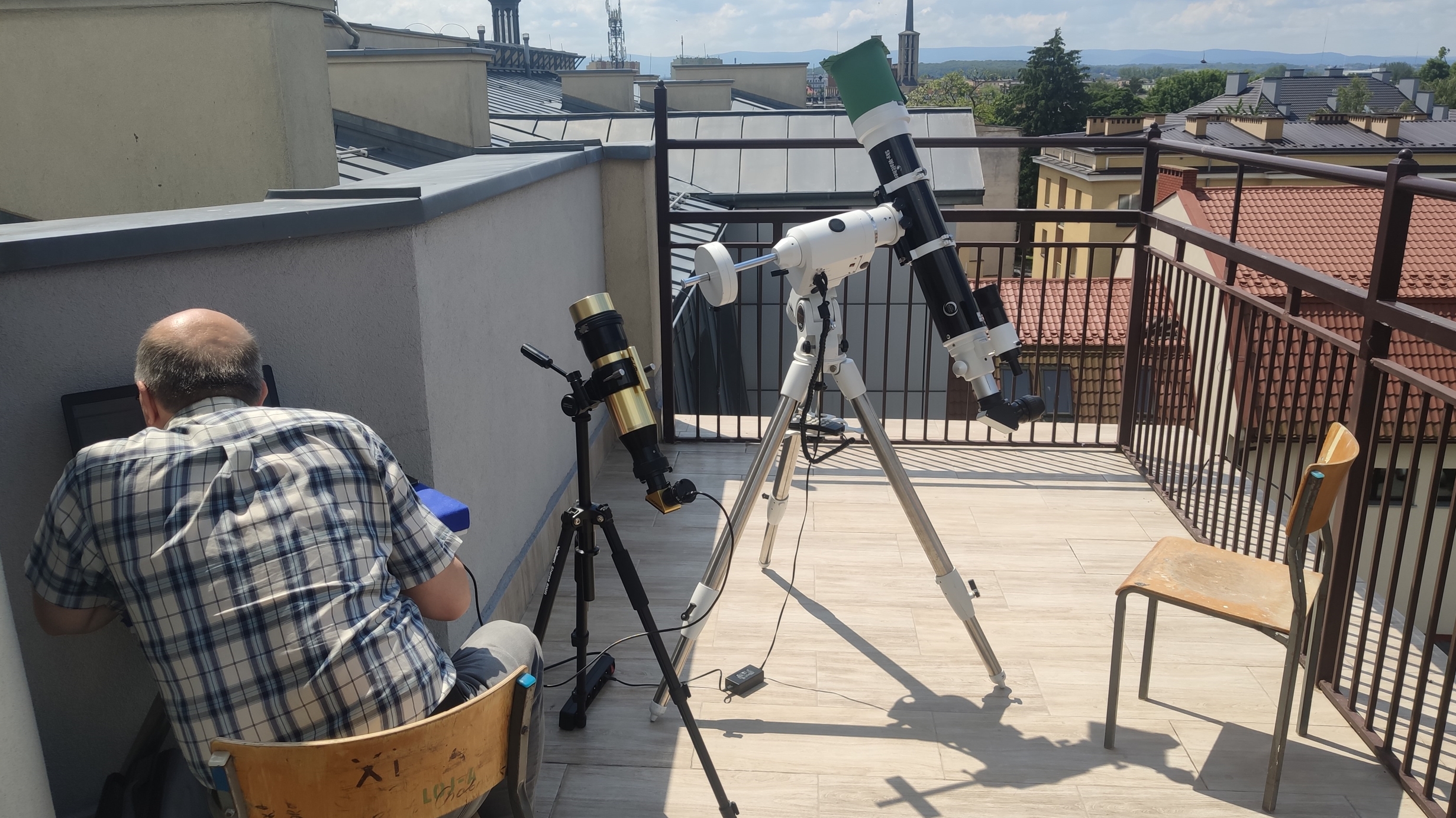
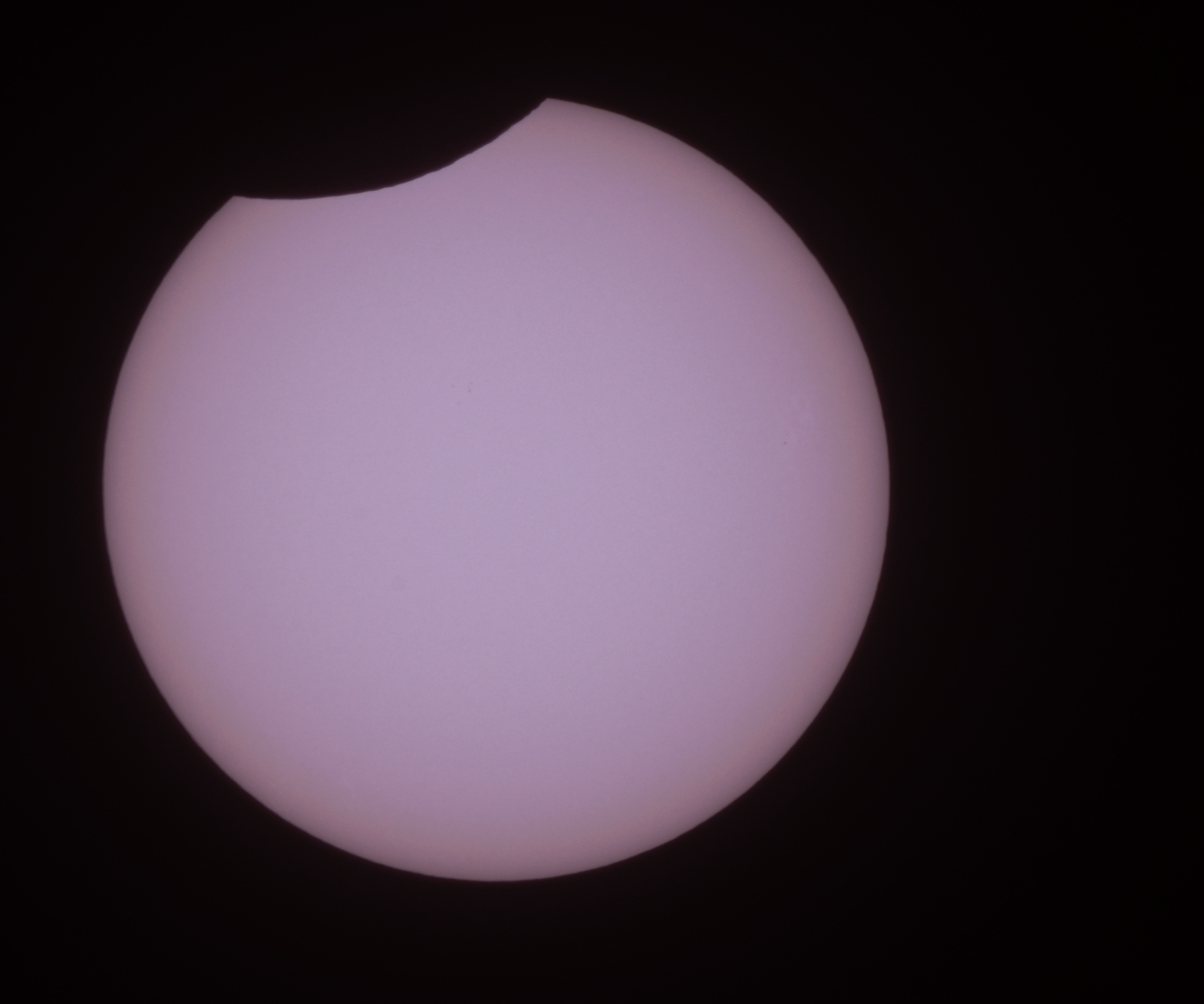
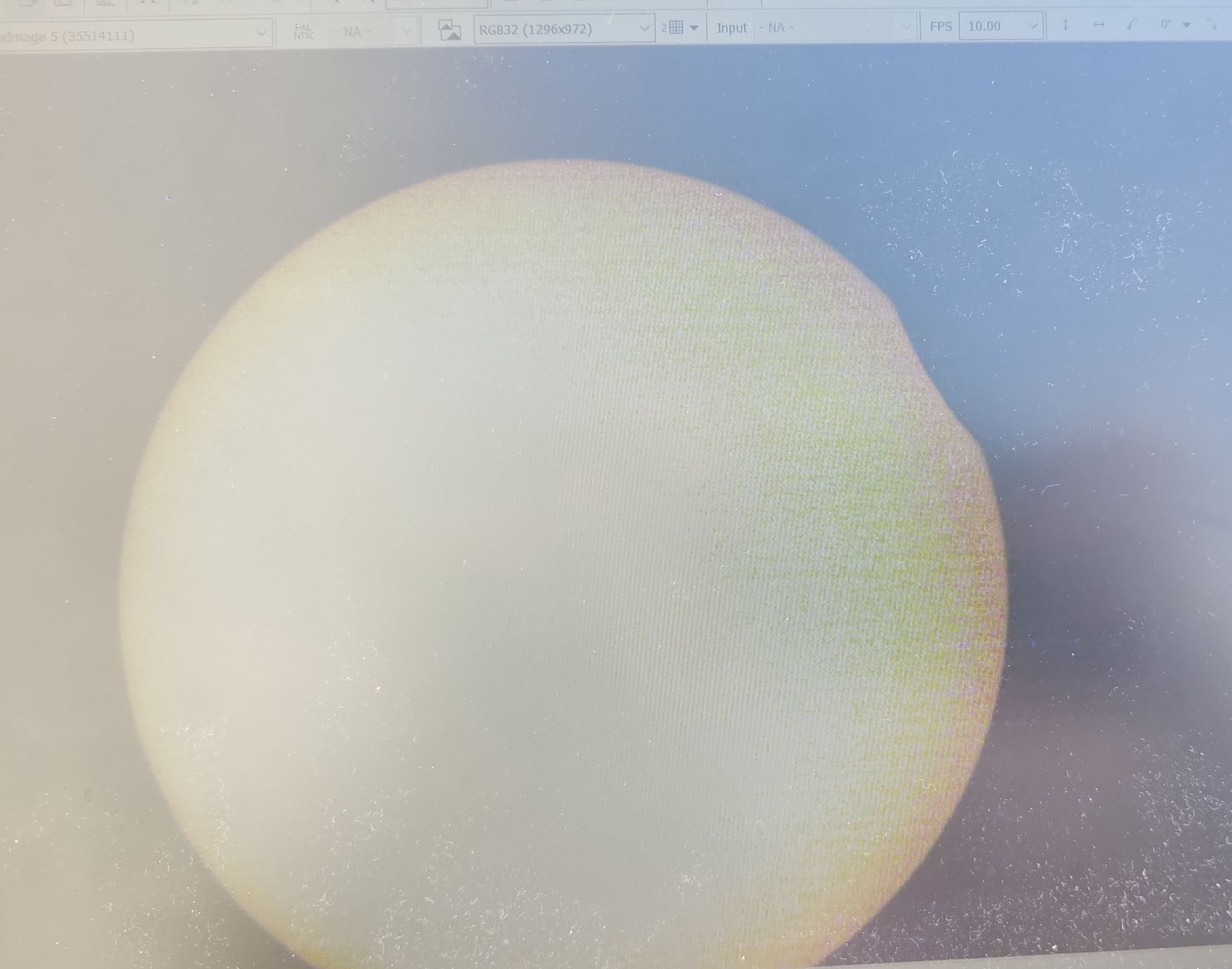
As was the case four years later, my eclipse observation was hybrid. After attending to the astronomical observatory, I started to download the records from the Webcamtaxi.com service webcams located in the north of the USA near the Canadian border, where the extension of the annularity path caused significant dawn disturbance. It’s well presented in the images below (Pic. 17).
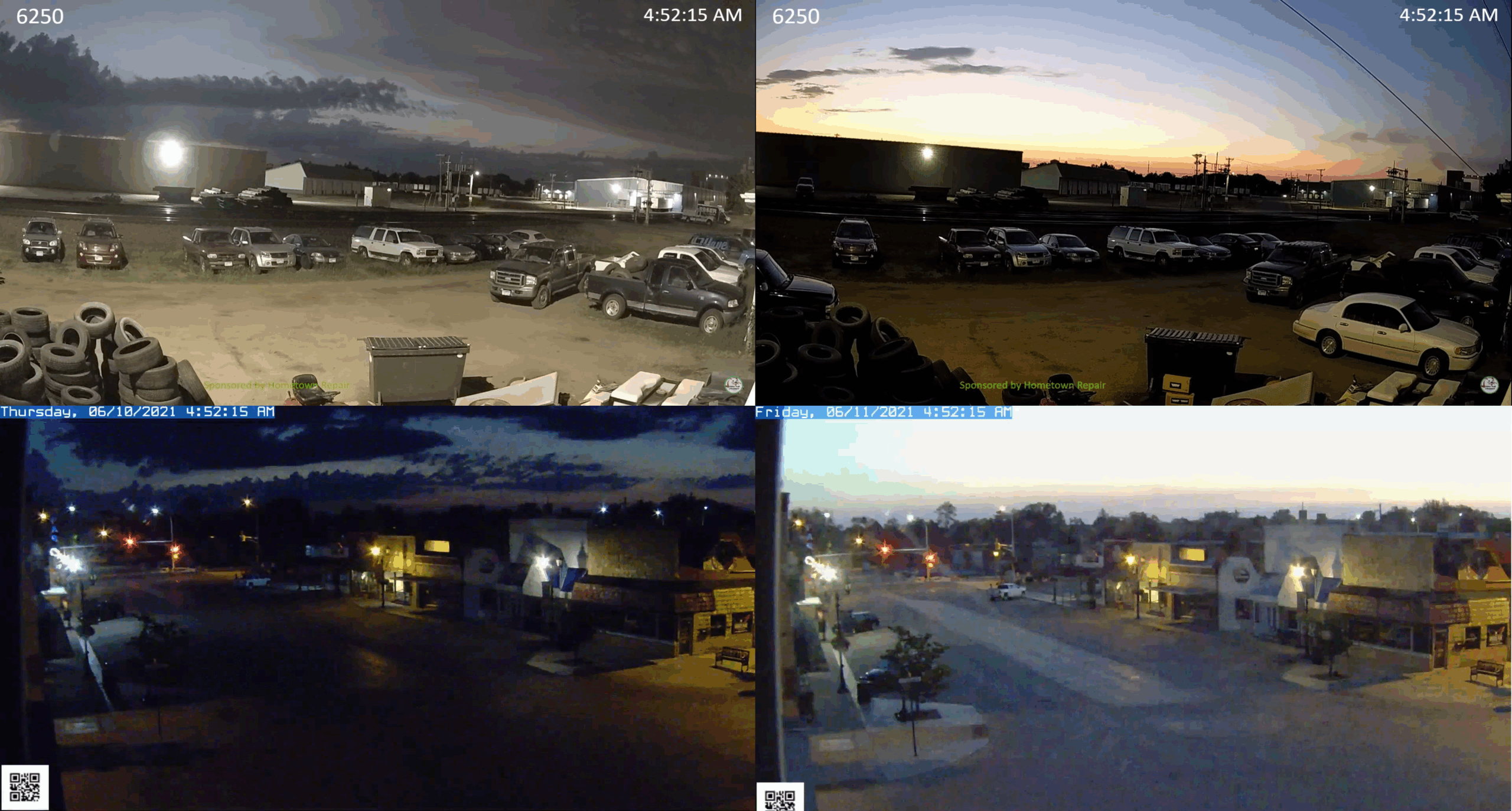
The annularity with obscuration of over 87% had a significant impact on scene illumination during mid-civil dawn. The twilight progress was slowing down and, according to the graph below, almost stopped (Pic. 18) shortly before the annularity took place. Next, as the greatest phase occurred, the illumination level started to increase. It’s pretty much the same as we have the whole Sun, which is constant in apparent brightness. The annular solar eclipse means the time at which the apparent brightness of the Sun doesn’t change in a general sense. The exception to this understanding can be only the limb darkening effect, which might be subject to small changes (Schultz, 2024). Since the Sun comes up closer to the horizon, it gets brighter as usual throughout annularity. Immediately after the third contact, the illumination level begins to increase more rapidly than usual.

I wasn’t successful with my primary goal of this observation – the reddening of potential noctilucent clouds, which could be visible that morning. On top of that, the weather above the US/Canadian border wasn’t good. Occasional thunderstorms blocked the sky from solar azimuth. In other cases, the cloudiness was far too extensive to investigate the potential presence of the noctilucent clouds.
TOTAL SOLAR ECLIPSE OF DECEMBER 4, 2021
This totality was one of the most difficult to reach by a typical eclipse chaser. By “typical,” I mean the person who can afford the eclipse journey to many countries except for inaccessible lands, where nobody lives for at least a year. Antarctica is an example of such a land, with restricted access due to harsh climate conditions and severely limited accessibility caused by its vast distance from the nearest civilized country. There were only a few groups located in the eclipse path, and thanks to them, we can watch fantastic videos from this event. The same as other observers, who decided to watch this eclipse from a cruising altitude. All the videos have been gathered on my separate website dedicated to the entire solar eclipse scientific plan, which also includes all forthcoming eclipse events in the next 50 years. Because this article refers to my own observations, particularly I will elaborate on the analysis of the umbra fleeting above the Falkland Islands, where the event could be observed around mid-civil dawn. In other words, this is another successful observation of a solar eclipse below the horizon, but regrettably, the webcam quality wasn’t even moderate this time. Alas, the Stellarium 25.1 ShowMySky model was essential for proper rendering of this underrated celestial phenomenon. In contrast to the Falklands, the webcam report from Ushuaia was really good and is described later in this section.

The approximate distance of the Falkland Islands to the geometrical eclipse limit was 350km, including refraction, as shown on the animation above. Because the eclipse occurred at the Moon’s descending node, the umbra emerged on the northern side of the path and proceeded towards the south. For a better understanding of this geometry, we can look at the image below (Pic. 20),
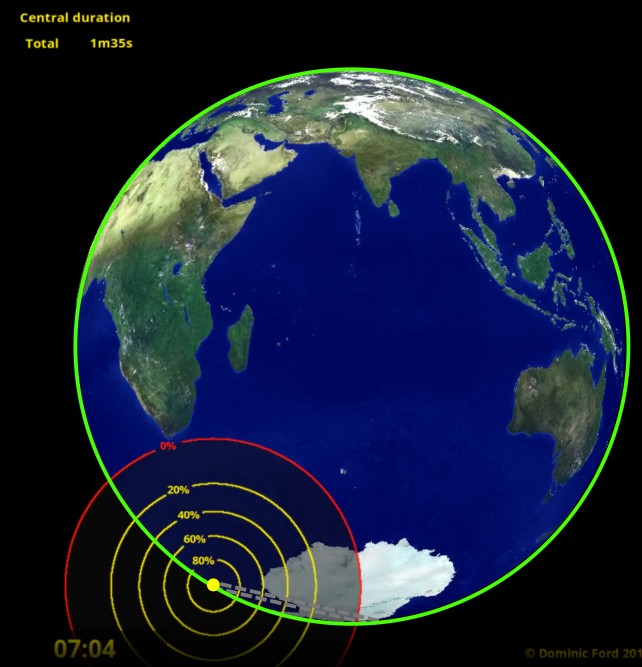
which displays the very beginning of the 2021 totality. The nodal position is the only case that determines the exact place of the first or last umbral appearance on the ground. The other ones will be explained on another occasion. The movement of the umbra was well reported on the webcam located at Stanley, which is positioned rather north (Pic. 21).

The total solar eclipse at civil dawn from the Falkland Islands position occurred between 4:01 and 4:05 local time, depending on the location. The eclipse itself was brief at the terminator line, lasting less than 90 seconds. At Stanley Ferry, the most significant effect was visible between 4:02 and 4:04 local time. Despite the poor quality of the webcams, the eclipse effect is still visible (Pic. 22).
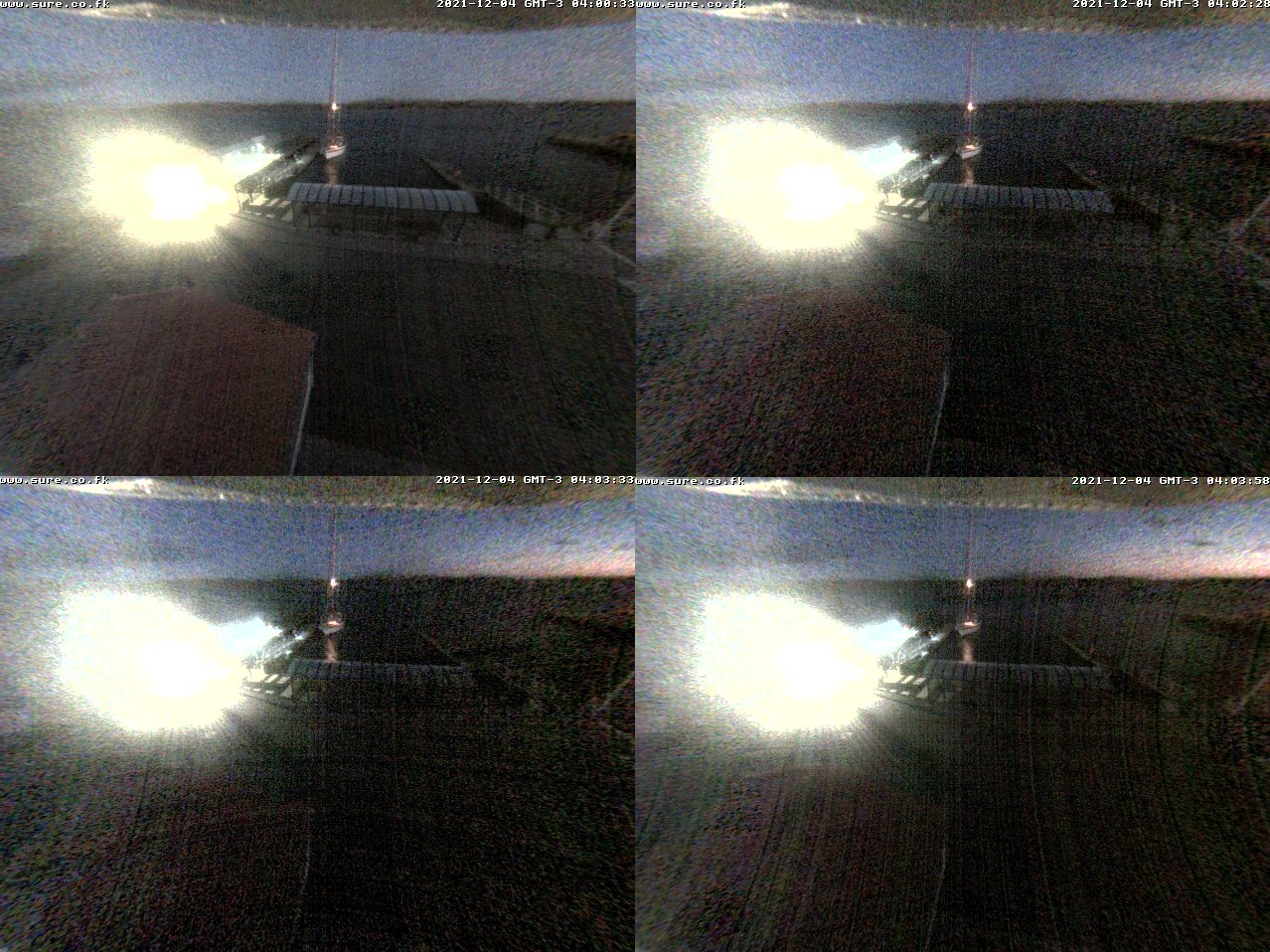
Unfortunately, apart from the eclipse impact, there is only a little information about the optical behaviors of the Earth’s atmosphere. Even after significant enhancements were made to these images, we are unable to identify the umbra boundary correctly (Pic. 23).

The identification of what happened on that day at dawn was possible thanks to the Stellarium ShowMySky model, as described in this article. The animations below show the sequence of images obtained by the webcam, overlaid with the SholwMySky atmosphere modeling (Fig. 24, 25).
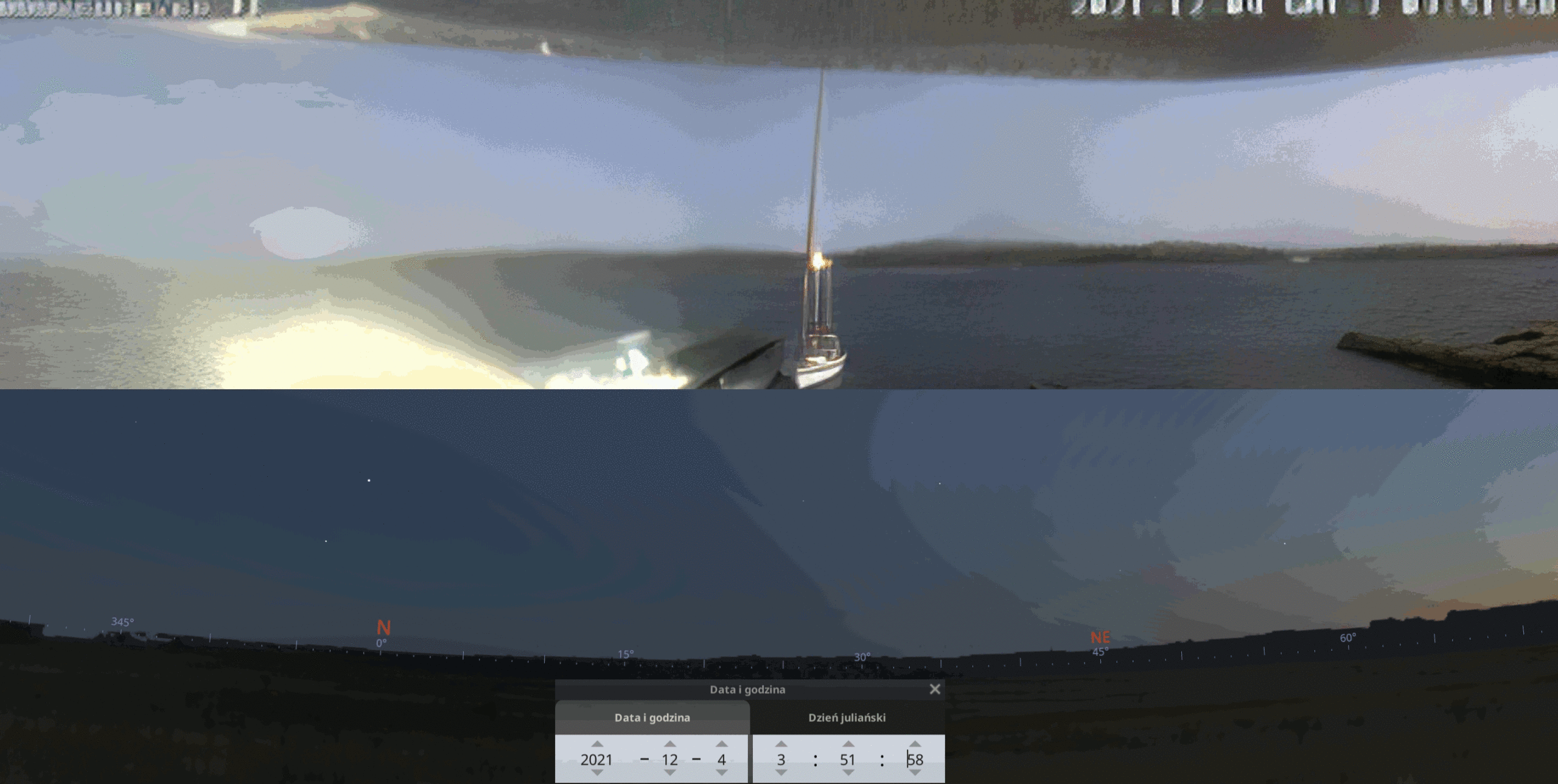
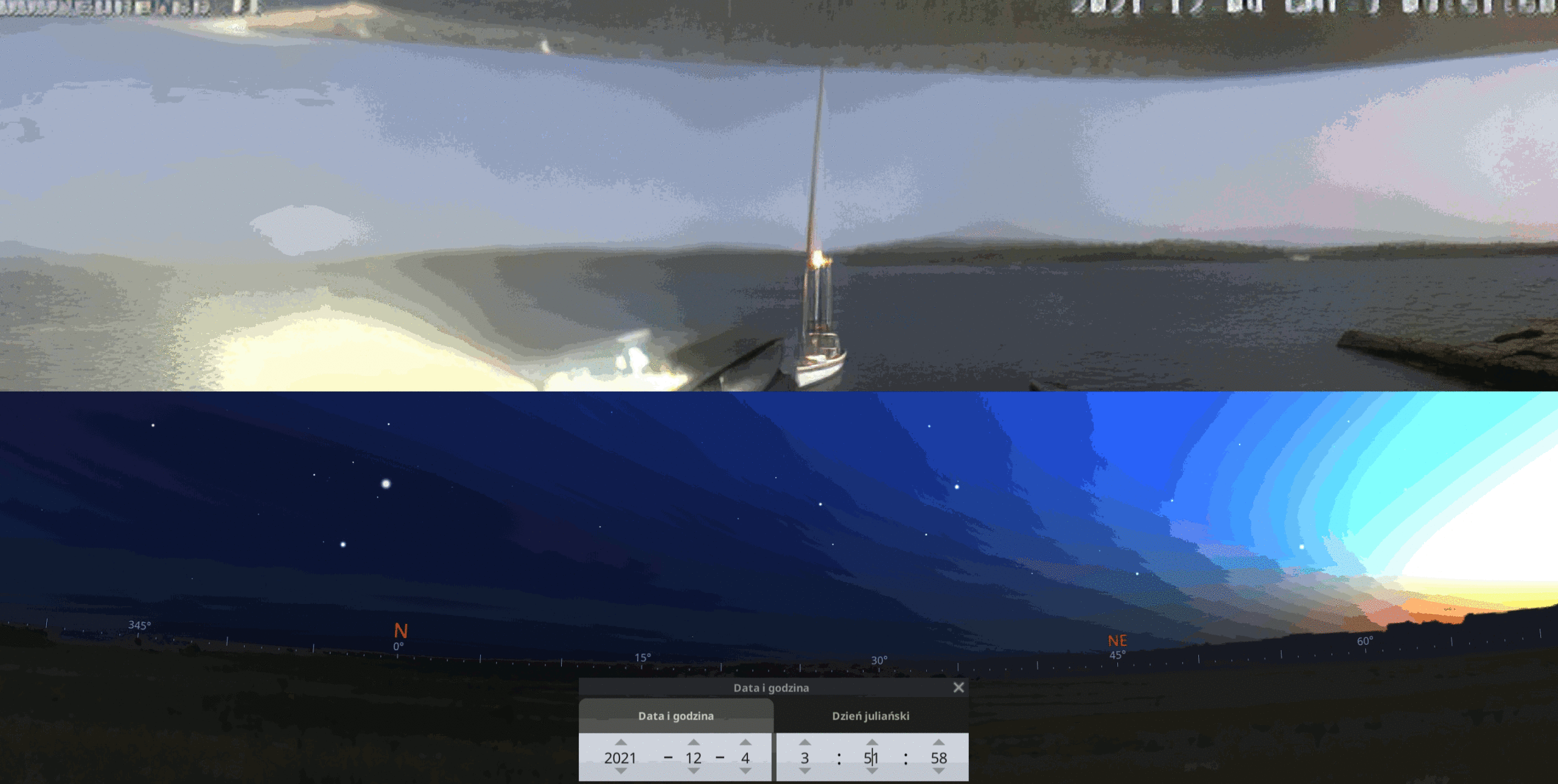
The webcam captured the twilight wedge—the boundary between primary and secondary twilight, along which the umbra was moving. To be more precised, the umbra came up from this boundary, marking the moment at which the Moon’s shadow touched the ground 350km ahead towards the east. The least eclipse-affected area of primary twilight appears overexposed in the lab-based rendering, whereas the fleeting umbra is much more visible. For an overall comparison of the brightness level, we can examine the shots below, which are separated by 24 hours (Pic. 26).

Worth mentioning is another webcam, which was directed awry to the water near Fitzroy. Only a small part of the frame covered the sky, which was also overexposed. The umbra movement was reflected on the water body (Pic. 27).

Finally, let’s see how dark it was during that morning. Because the Falklands were ideally located at the extension of the totality, the light level conditions could resemble almost astronomical twilight (Pic. 28).
The other location, where this eclipse was observed remotely, was Ushuaia – the southernmost town in the world. The greatest eclipse, with an obscuration of about 96%, occurred around 4:04 local time (GMT-3), at a solar depression of 4 degrees, and the distance to the umbra was over 510 km from that location. There was a moment at which everyone could guess that the umbra was visible, but regrettably, there was a crepuscular ray cast by the distant cloud, which was already illuminated by the rising solar crescent (Pic. 28).


The weather in Ushuaia is problematic; therefore, capturing an analog non-eclipse dawn at a similar time is challenging. I had to wait another year to repeat the observation, which hadn’t covered the difference well enough, as the cloudiness at solar azimuth was still quite significant (Pic. 30).
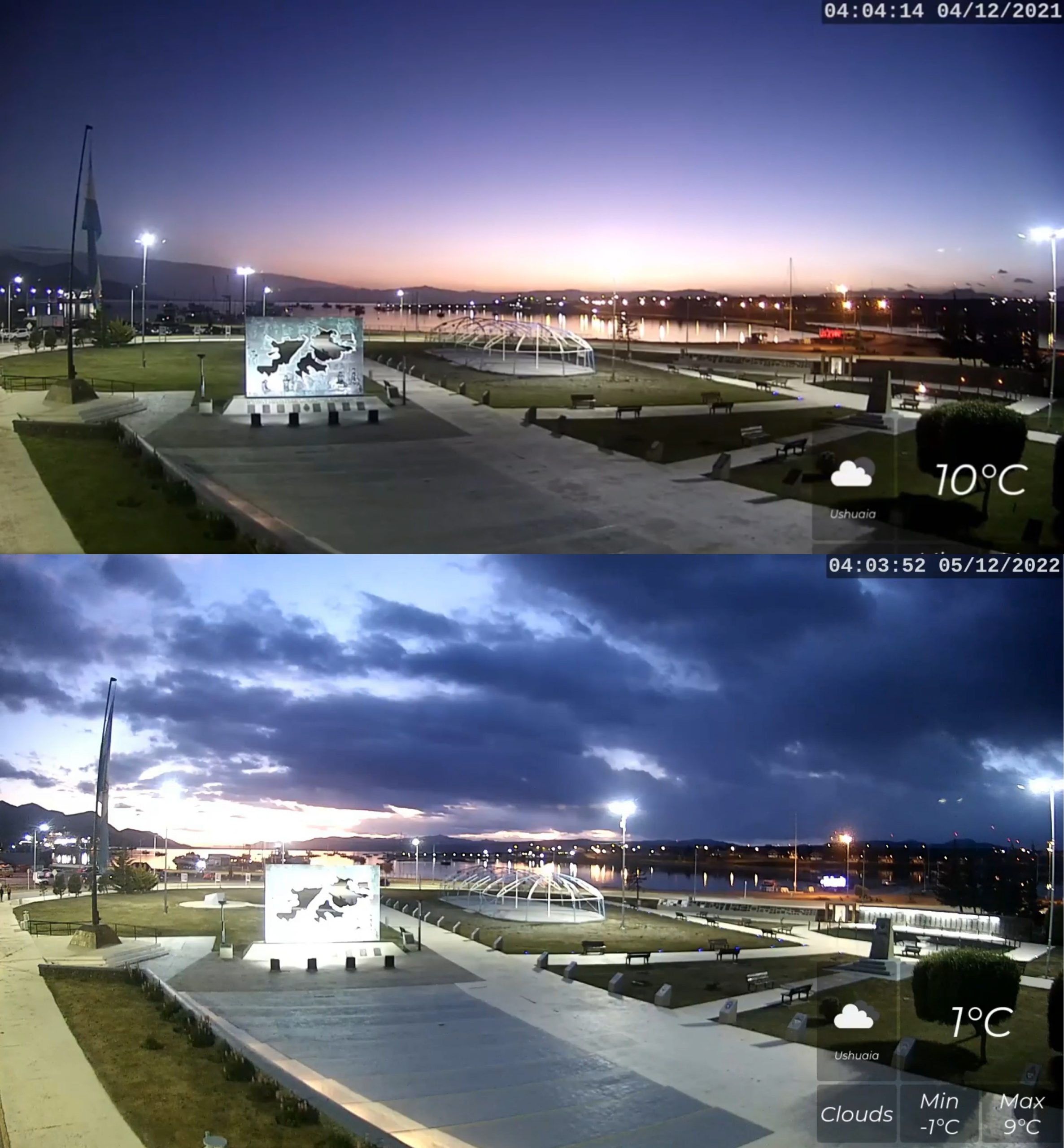
PARTIAL SOLAR ECLIPSE OF OCTOBER 25, 2022
This eclipse was visible from Europe, with the most significant point located in central Russia, where the obscuration reached over 80%. The penumbral effect was visible over most of the European continent in the early afternoon. In a holistic sense, the event could be seen well on Sat24.com weather satellite imagery (Pic . 32). Due to quite dense cloudiness above the continent, the diminishing sunlight reflection was noticeable without problems, especially when moving eastwards.

At my observation venue in south-eastern Poland, the maximum obscuration was slightly more than 39%, as the magnitude hovered around 0.5. This particular case means that the lunar limb reached the very center of the Sun’s disk. The primary consequence of it is the opposite effect of limb darkening, which can be observed mainly in the sky. Below, you can see the comparison of two skies captured at an angular distance of about 90 degrees from the Sun (Pic. 33). Despite a very minor difference in brightness, another disparity can be noticed. The sky on the left looks bluer than on the right. Considering the limb darkening effect, which is an inherent part of the shining Sun, now we are pretty close to the situation, at which its influence is the lowest. This is because the most significant portion of the solar disk “responsible” for the limb darkening effect is taken out of the scene. Of course, the limb darkening effect varies across the Sun’s disk, but for the sake of simplification, we can take into account the most peripheral areas. The image below was captured exactly 13 minutes before the eclipse’s culmination, at an obscuration of 36.3% and a magnitude of 0.475.
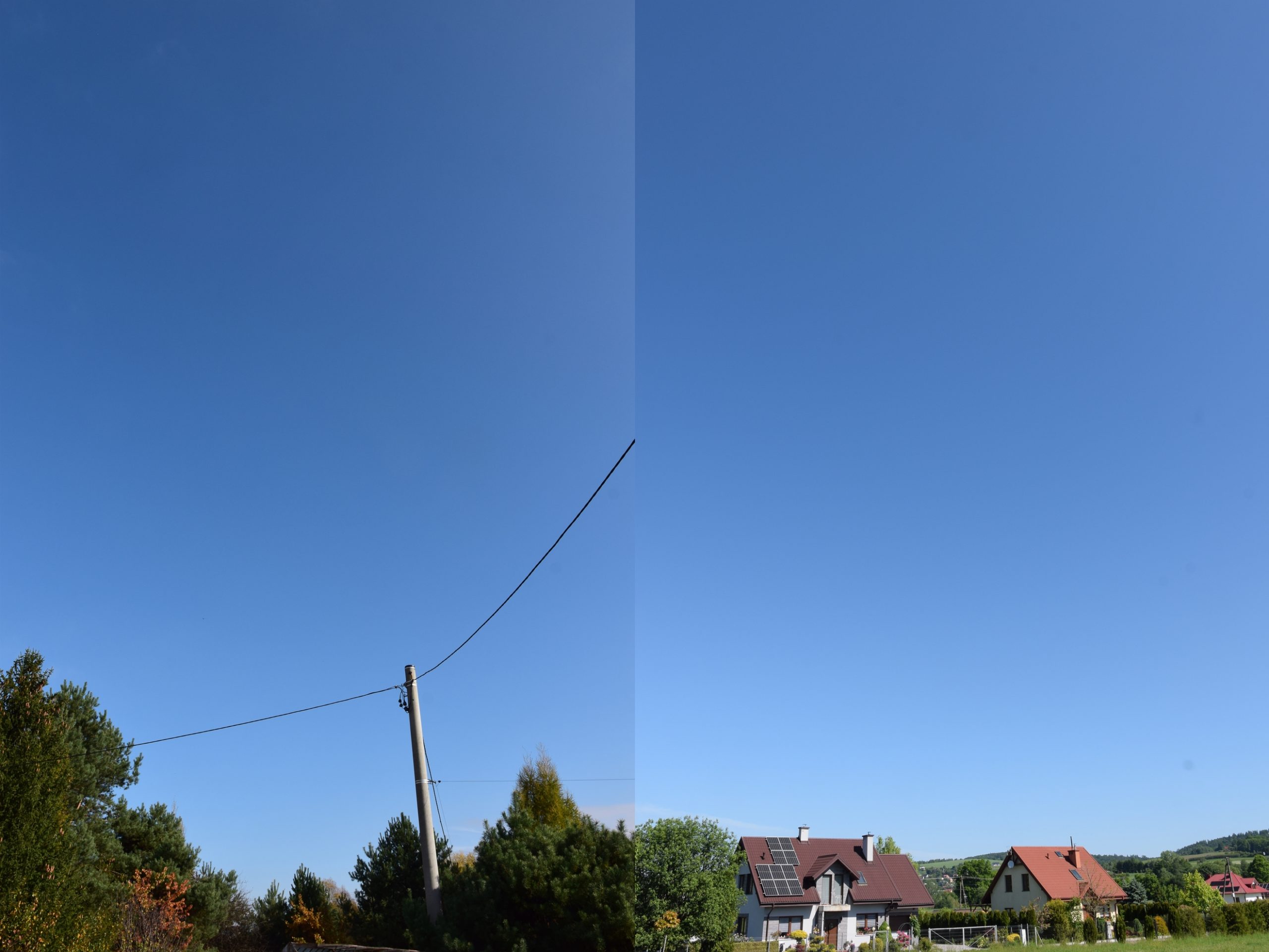
The sky looks bluer because we are effectively “the closest” to an ideal definition of Rayleigh scattering, which is based on a white light. The Sun, being a G-type main-sequence star, shines in yellowish anyway, but its light extinction caused by the photosphere emphasizes this tinge as the sunlight is shifted slightly to the red. In turn, the sky is a tad less blue, likewise in the right image. The obscuration of 36% isn’t significant enough to cause darkening of the scene, which makes the effect visible even at fixed image parameters. On the other hand, the minor light level drop can be noticed. Returning to the issue with the sunlight tinge properties and its translation into the sky colour, we must be aware that an analog influence can be noticed in the scene. By having a myriad of various objects, which reflect the light at different wavelengths, this specific thing passes unnoticed. Usually, the best way to capture the impact of limb darkening on the scene is by using a plain-coloured surface, unless the eclipse is deep enough and the limb darkening outcome can be visible without any aid. The other image provided below shows an experiment with the simple white sheet, on which the Sun was shining on October 25, 2022 (Pic. 34).

At first glance, we can spot a slight darkening, and it’s undeniably true, since almost 40% of the solar disk was covered. However, the white sheet on the left is practically white! It reflects whitish sunlight reaching its surface. Conversely, the same white sheet in the right image reflects yellowish light instead. The difference is minor, but eagle-eyed observers can notice it, especially by examining the crumpled area underneath. How could this particular situation be explained? An answer can be found in the graphs below (Pic. 37 – 39).


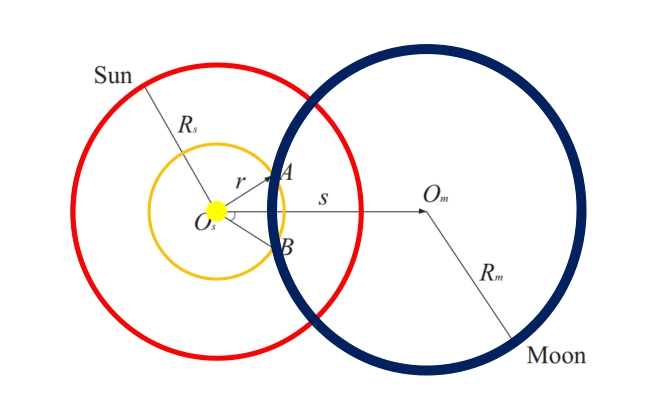
The partial solar eclipse results in reduced solar intensity. This solar intensity has its wavelength proportion, which is subject to changes as the lunar disk covers different areas of the solar disk. The geometrical relationship between the limb darkening and a small partial solar eclipse should give us an idea about the changes in proportion between the center and peripheral areas of the Sun. Considering the image on the left, in which the lunar limb advances the points A and B, around one-fourth of the aforementioned peripheral area is hidden, whereas the center of the solar disk, marked with the point O, still contributes to the overall solar intensity. For this reason, the light coming from the Sun has different wavelength proportion, depicted in the image above (Pic. 37), where the X states about the distance between the center of the Sun and center of the Moon (marked as s in the picture 38) and Inorm says about normalised solar irradiance comprised of various wavelengths covering the spectral range of interests (Koepke at al, 2001). The gray line shows what everything could look like if limb darkening didn’t exist. For the partial eclipses with a magnitude smaller than 0.50, we need to consider the X values between 1 and 0.5. Following the chart above (Pic. 38), all wavelengths tend to be most enhanced at X=75 (Koepke et al., 2001), which corresponds to an eclipse magnitude of 0.25. According to both charts (Fig. 37, 38), the X value of 0.55, corresponding to an eclipse magnitude of 0.45, resembles the non-eclipse conditions in terms of limb darkening. It would mean that the brighter central region reduces its contribution to the general solar intensity, yet before the lunar limb reaches the very center of the Sun. Though the sky might be bluer due to reduced solar intensity, the experiment with the white sheet contradicts the computations shown on both graphs. The bluer tinge of the sky can arise out of a clearer atmosphere on the day when the eclipse occurred. This is another factor that can explain it. Unfortunately, there is a discrepancy between the charts above (Pic. 37, 38) and the other experiment, which must be resolved on another occasion. Threading this way, two reasons make the sky a bit bluer during the eclipse day. The first one is the level of brightness, which has dropped as a consequence of the Sun’s disk obscuration, and another one, which lies in the degree of atmosphere clarity, including the level of humidity. More details about it you can find in this text, which gives an explanation about the sky tinge with respect to its overall clarity. According to the scientific results above (Pic. 37, 38), there is no evidence of a negative limb darkening effect, except in the experiment with a white sheet, which realistically underpins these results. Looking at it from the other side, but considering the private IP camera-based records, the limb darkening science included above (Pic. 37, 38) fits better. The interior IP camera Xbilitz Isee 2, working at a building construction site, was able to capture a slight influence of the partial solar eclipse on the scene. The images are results of motion detection. Additionally, the weather conditions weren’t great enough, so picking up correct shots was quite challenging. Finally, there were two shots compared to each other, which represent the same situation (Sun behind thin clouds and nobody in the frame), but it wasn’t possible to get them from the eclipse culmination. The image included an eclipse-induced scene was taken at 12:08 GMT+2, almost 20 minutes before the peak of the eclipse, when the obscuration exceeded 34% only, and the magnitude was estimated at 0.455. As per the charts above (Pic. 37, 38), this magnitude represents somewhat the “zero point” of limb darkening effect, being very close to the X=0.55 value. The scene looks just a bit darker with a slight shift in coloration towards reddish (Pic. 40, 41), which can be explained by the specification. This camera wasn’t for purposes such as this, and the observation with the sensor 1/4″ CMOS and 720p HD resolution was simply casual, so the result isn’t reliable enough in this case.

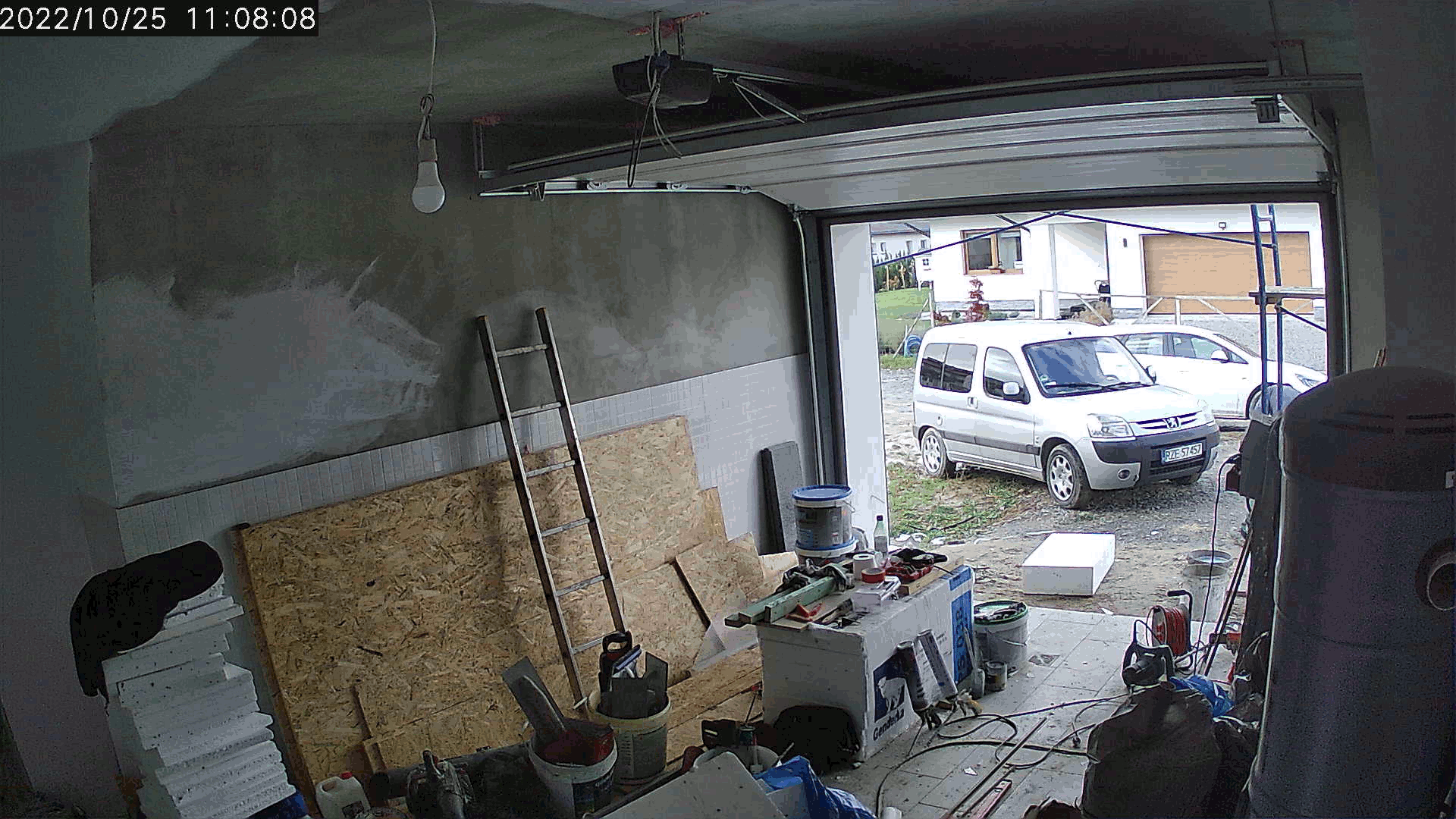
The partial solar eclipse of October 25, 2022, observation was successful, but incomplete with regards to the level of knowledge. The limb darkening effect will be the subject of investigation, particularly during annular solar eclipses.
Mariusz Krukar
References:
- Bernhard G., Petkov B., 2019, Measurements of spectral irradiance during the solar eclipse of 21 August 2017: reassessment of the effect of solar limb darkening and of changes in total ozone, (in:) Atmospheric Chemistry and physics vol. 19, i.7 p.4703-4719
- Chaubey S., Singh G., Kumar Singh A., 2022, Measurements of limb-darkening effect and solar radiation during the partial solar eclipse of 21 June 2020 at Varanasi (in:) J. Earth System Sciences vol. 131 I. 57, Indian Academy of Sciences
- Grobner J., et al., 2017, Spectral solar variations during the eclipse of March 20th 2015 at two European sites, (in:) AIP Conference Proceedings, 1810, 080008
- Koepke P., Reuder J., Schween J.H., 2001, Spectral variation of the solar radiation during an eclipse, (in:) Meteorologische Zeitschrift, 10(3):179-186
- Lee S.H., Lee S., 2012, Illuminance during a solar eclipse with limb darkening: A mathematical model, (in:) Journal of the Korean Astronomical Society v.45, 111-116.
- Ockenfuß P., 2018, Simulation of solar irradiance during total solar eclipse, Bachelor’s Thesis at the faculty of physics, Ludwig-Maximilians-University Munich
- Rahoma U.A., et al., 2021, Assessment of spectra of solar radiation during the partial solar eclipse of 21 June 2020 at, Tanta, Egypt, (in:) NRIAG Journal of Astronomy and Geophysics, vol. 10, 2021
- Raponi A., et al., 2011, The Measurement of Solar Diameter and Limb Darkening Function with the Eclipse Observations, (in:) Solar physics, 278 (2)
- Saito K., Hata S., 1960, Limb-Darkening of the Sun Determined from the Light Curve during the Annular Phase at the Annular Eclipse on April 19, 1958, (in:) Publications of the Astronomical Society of Japan, vol. 12, p.143 (1960)
- Schultz D., 2024, Photometric Measurement of Limb Darkening at the October 14, 2023 Annular Eclipse, (in:) Bulletin of the AAS
Links:
- Britannica.com: limb-darkening
- https://earthsky.org/sun/what-is-limb-darkening/
- http://xjubier.free.fr/en/site_pages/solar_eclipses/ASE_20200621_pg02.html
- https://www.n2yo.com/space-station/
- https://scijinks.gov/solar-eclipse/
- https://www.space.com/2024-solar-eclipse-astronaut-photos-space-station
- https://www.digitaltrends.com/space/solar-eclipse-iss/
- Nasa.gov: 2024 total solar eclipse from space
- https://www.sure.co.fk/
- Sklep.delta.poznan.pl: IP rotated camera Xlibitz iSee 2 Specs (Polish)
Forums:
- https://www.reddit.com/r/AskPhysics/comments/u5r690/why_is_the_sky_blue_why_are_sunsets_red/
- https://www.quora.com/Why-is-Rayleigh-scattering-inversely-proportional-to-the-4th-power-of-wavelength
- https://www.cloudynights.com/topic/650012-solar-limb-darkening-and-color-spectrum/
- https://astronomy.stackexchange.com/questions/50826/what-experiments-can-be-performed-during-a-solar-and-lunar-eclipse-respectively
- https://www.cloudynights.com/topic/900012-annular-eclipse-ambient-light-wavelength-shift-due-to-limb-color/
- https://astronomy.stackexchange.com/questions/39337/when-does-a-solar-eclipse-become-noticeable/40169#40169
My questions:
- https://www.cloudynights.com/topic/959037-rayleigh-scattering-during-partial-solar-eclipse/
- https://astronomy.stackexchange.com/questions/59923/how-rayleigh-scattering-looks-like-during-partial-solar-eclipse
Wiki:
- Diffuse_sky_radiation
- G-type main-sequence star
- Limb_darkening
- Rayleigh_scattering
- Solar saros 137
- Solar_eclipse_of_December_26,_2019
